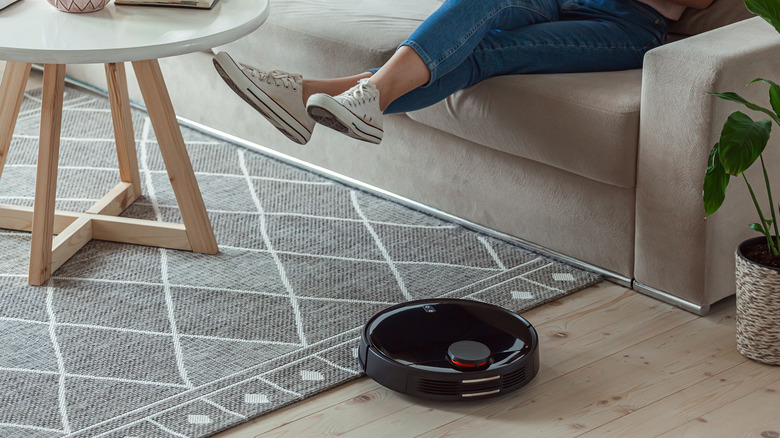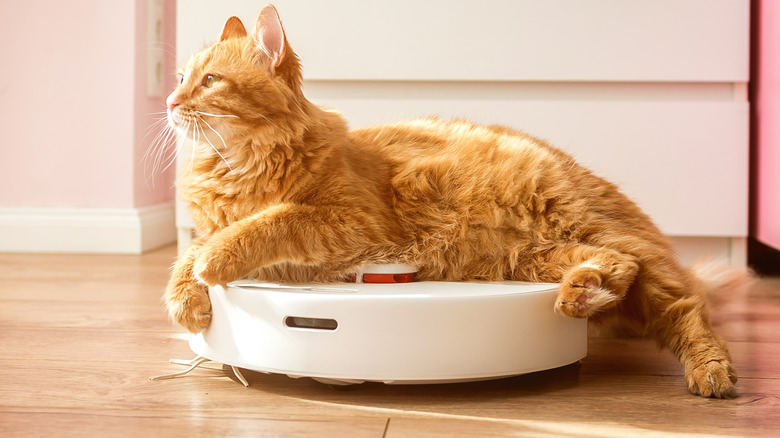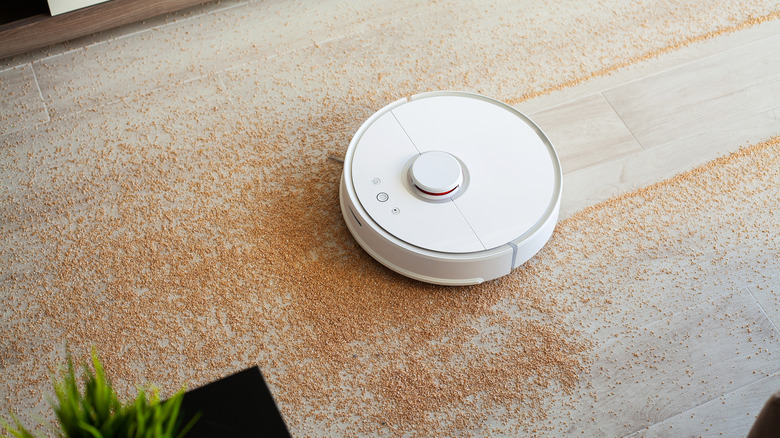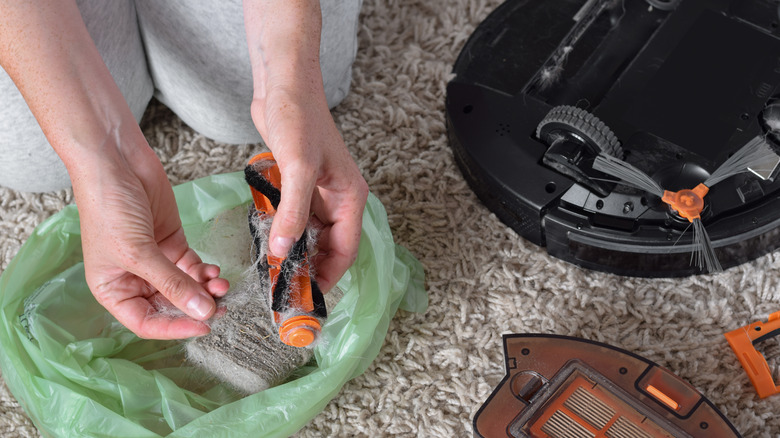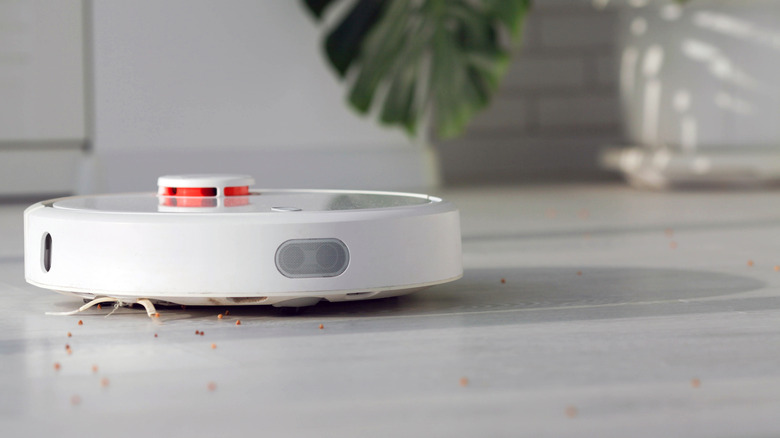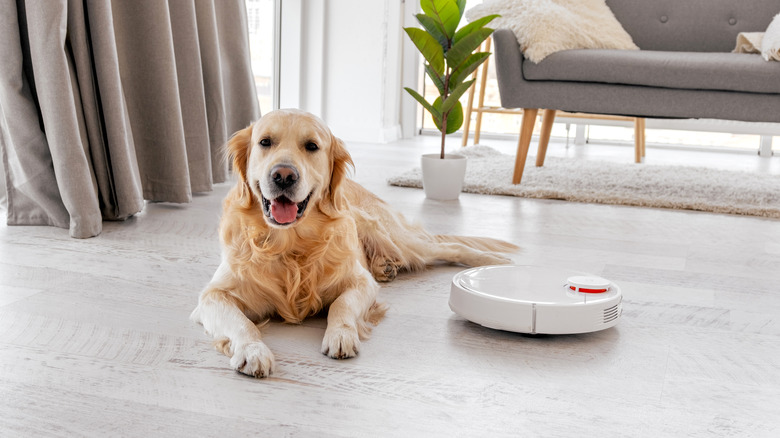Things You Should Know Before Buying A Robot Vacuum
If you're looking to buy a robot vacuum, you've likely decided that the upfront investment is more than worth it when it comes to keeping your floors clean without much effort on your part. In fact, once you purchase a robot vacuum for your home, you will likely wonder how you survived for so long without one.
Robot vacuums have many benefits, as per Think Crucial. The independence is their main draw as they do nearly all the work for you. They can even clean your house when you're not home as they can be programmed to clean whenever works best for you. Many are smart enough to return to their charging stations on their own when their battery starts getting low, meaning all you have to do is keep the charging port plugged in. The built-in sensors make this type of vacuum incredibly intelligent as well. For starters, you won't have to worry about the vacuum falling down stairs as it can be programmed to stop before hitting those areas of your home. The sensors can also pick up on dirty spots of the floor and direct the vacuum to focus on those areas.
By now, you're probably ready to jump into your car to the nearest appliance store and buy your own robot vacuum. Before you do so, however, take a quick peek at the following tips you need to know before buying a robot vacuum.
You get what you pay for
As with all appliances, the more you spend, the more perks you get. Most robot vacuums cost more than the average hand-held vacuum cleaner, although you can definitely find robot vacuums without all the bells and whistles that won't dent your wallet too much. PCMag points out that you can expect to spend anywhere from $200 to $1,000 on a robot vacuum.
On the lower end, you might end up sacrificing some of the more essential features that make owning a robot vacuum superior to an upright or canister vacuum. For example, robot vacuums nowadays have the ability to connect to your home's Wi-Fi network and boast their own app. Through this app, you can program the vacuum to do a multitude of things, such as clean at specific times of the day. You can also create a map of your house that allows the vacuum to understand the boundaries of each room and prevents it from cleaning the same space over and over again. With a cheaper model, you might not get this perk, meaning your robot vacuum will bounce off walls and furniture and often continue cleaning the same area until you intervene. If you don't want to spend too much and don't mind not having a bunch of extra bells and whistles, at the very least, a lower-end robot vacuum will do exactly what it's supposed to do: clean your floors independently.
Your dirty floors may not be a match for a robot vacuum
Before buying a robot vacuum, you should first take stock of how dirty your home gets to determine which vacuum is right for you. Keep in mind that heavily soiled floors and carpets may not be a match for most robot vacuums, even the highest-end ones, as per Tom's Guide. This means that you may have to store a handheld vacuum of some sort to bring out in the case of extreme messes. However, for day-to-day use, a robot vacuum will still be a lifesaver.
Certain models are better at cleaning pet hair while others are pretty ineffective at cleaning thick carpets. You will need to choose a robot vacuum based on the needs of your home. Vacuum test engineer for Consumer Reports Susan Booth says that "Robotic vacuums can be a hassle-free way to maintain your floors daily, removing surface debris between the times you use a full-sized vacuum for deeper cleaning." This means that as long as your floors aren't covered in an inch of dirt and debris, a robot vacuum will be a great addition to your cleaning arsenal. However, you may still need to do a deep clean with a regular vacuum every once in awhile to keep your floors and carpets as clean as possible.
Robot vacuums require some regular maintenance
If you're dreaming of a completely self-sufficient vacuum, you may have to wait a few more years. While robot vacuums are the most independent and tech-savvy vacuums on the market, you should be aware that there are still some regular maintenance tasks that you will be required to carry out, as per TechHive. Unless you splurge for one of the most expensive models that empties its waste cannister by itself, you will need to do this for your vacuum. The frequency with which you'll need to dispose of its contents will depend on how much of your house the vacuum has cleaned and the level of dirtiness. Note that the waste capacity of most robot vacuums is equivalent to a quart of milk.
Another maintenance task that your robot vacuum will require of you is keeping its brushes and filters clean. This often means you'll need to pull apart the various parts of the vacuum to access the different brushes and rollers and shake them off into a trash bag. If these parts are heavily soiled, you may need to wash them in the sink and let them dry before placing them back into your vacuum. If you don't clean these parts enough, you risk permanently damaging your robot vacuum or, at the very minimum, rendering it less effective at picking up dirt, dust, and hair, among other debris.
Robot vacuums require a clutter-free space
While all vacuum cleaners require you to tidy up any clutter before attempting to clean a room, robot vacuums are even less effective at cleaning when forced to navigate an obstacle-filled space. Before setting your robot vacuum out to clean, you'll need to make sure any loose items, toys, clothes, and other obstacles are picked up off the floor and stored away. While robot vacuums have sensors that prevent them from running into any obstacles they encounter in their path, they won't be able to clean properly if the floor is too cluttered. Additionally, robot vacuums are known for "eating" small, loose objects, such as electronic cords and shoelaces, as per TechHive. These items may get stuck in your robot vacuum and, in some cases, cause permanent damage.
If you decide to go for a higher-end model, note that you can create boundary zones within the vacuum's online app that tell it where to avoid when cleaning, according to Family Handyman. This is great for those days when you're running late and forget to declutter the floors of your home but still need your vacuum to clean while you're out. You can simply toss all the clutter into a corner of the room and program the robot vacuum to stay out of that zone while cleaning throughout the day. Even with lower-end models, you can put up a physical boundary in the form of a piece of furniture to accomplish the same goal.
Your fur babies might not like it
Before going out to purchase a robot vacuum, you may need to first consider the temperaments of the various members of your household — specifically, the fur-based ones. Many dogs and cats, in particular, do not take well to vacuum cleaners, and robot vacuums are no exception. How does your pet typically behave when you bring out the vacuum? Do they get agitated and vocalize or even attack it? If your pet shows troublesome behavior around your vacuum, they will likely react in similar ways with a robot vacuum.
Even if your pet doesn't get along well with vacuums, you might still feel your home will benefit from the addition of a robot vacuum. In this case, you will just need to take a few extra precautions when running your robot vacuum to avoid potential damage from your pets and/or distress to your pets. One way to accomplish a stress-free clean is to separate your pets from the vacuum while it's running. Dog's Best Life recommends not trying to force your pet to accept the vacuum if they are particularly opposed to its presence as this can exacerbate the issue. The best way to deal with a pet's aggressiveness and anxiety around the vacuum is to praise and reward them with treats for any calm behavior that they demonstrate. The publication points out that your pet may simply need time to adapt to the vacuum.
